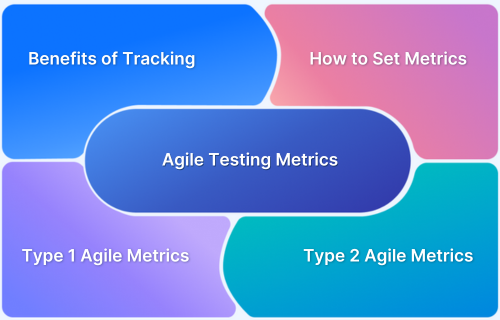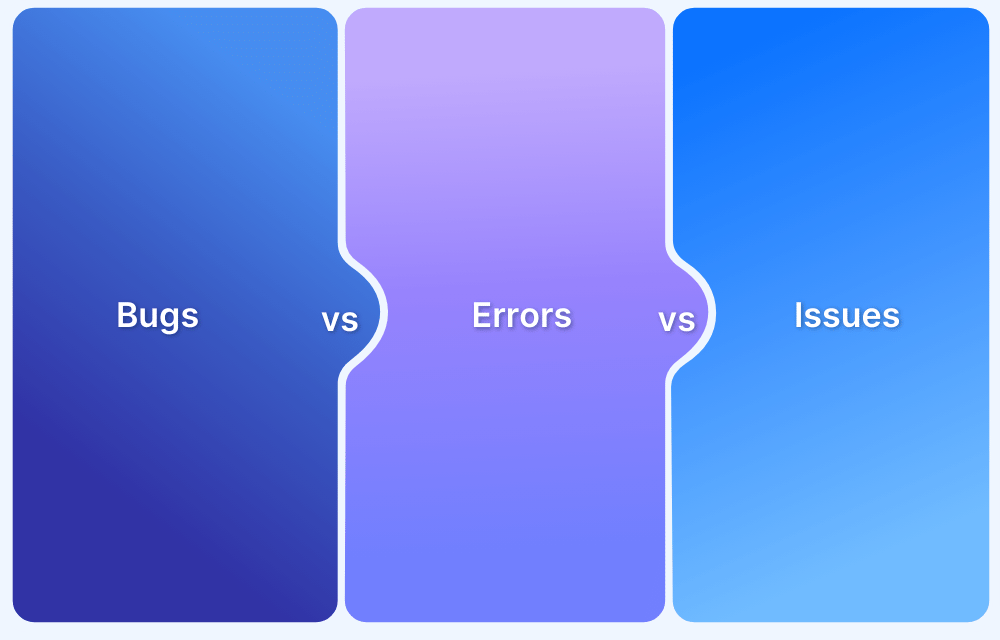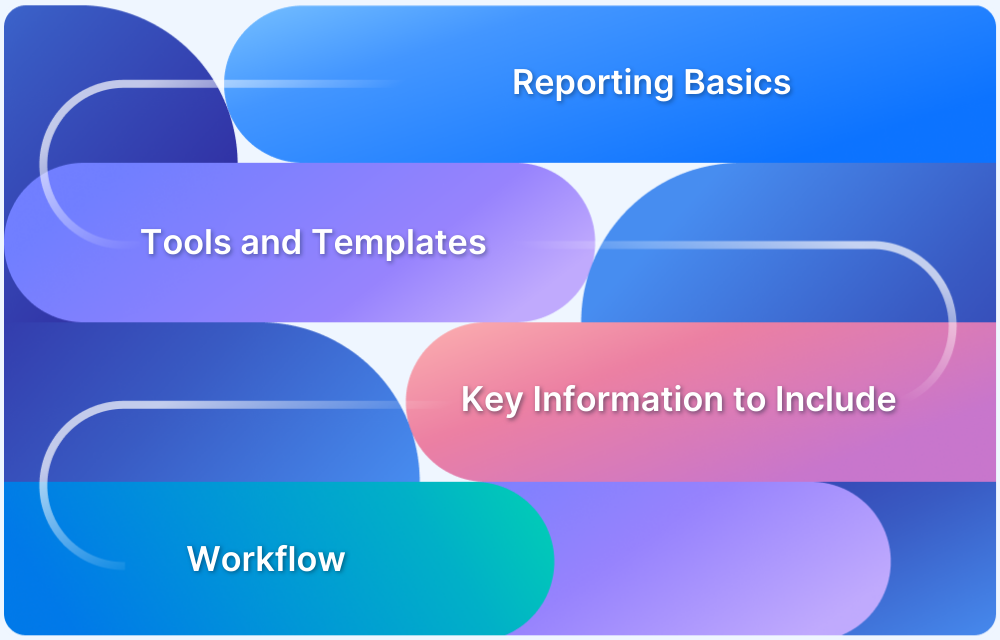Without clear KPIs, automation testing teams struggle to measure effectiveness, align with business goals, and showcase ROI, leading to inefficiency and missed opportunities. Well-defined automation KPIs provide the structure needed to track progress and demonstrate value.
Overview
Automation metrics and KPIs are measurable indicators that assess the performance, efficiency, and impact of automation testing, with a focus on aligning results to business goals.
Automation Testing KPIs include:
- Total number of test cases executed (passed / failed / blocked)
- Total number of bugs reported, including accepted, rejected, deferred
- Number of critical bugs
- Number of bugs detected post-release
- Percentage of test cases passed (passed / total executed ×100)
- Percentage of test cases failed or blocked
- Percentage of bugs fixed vs reported
- Average time to fix bugs
- Test run efficiency (e.g. # tests run per unit time)
- Bug density (bugs per modules/features)
This guide covers all relevant information about KPIs, the importance of test automation KPIs, and some examples of KPIs you can adopt for your testing automation KPIs.
Understanding KPIs in Automation Testing
Key Performance Indicators (KPIs) in automation testing are measurable values that help teams evaluate how effectively their testing efforts are contributing to overall software quality and business goals.
While automation metrics capture raw data points like the number of tests executed or bugs reported, KPIs highlight the most impactful measures that directly reflect success.
Defining the right KPIs ensures:
- Clear visibility into the efficiency and reliability of automation.
- Alignment between testing outcomes and business objectives.
- Evidence of ROI from automation investments.
- A structured way to track progress and identify improvement areas.
Why should you have KPI for Automation Testing Teams
Following are some of the reasons why the QA teams should have KPI for automation testing.
- The primary goal of KPIs is to demonstrate the performance of your team’s testing process. It indicates whether your team has achieved the objectives or if it is at least working towards achieving its goals.
- KPIs will also enable your team to strategize better if the objectives are not achieved.
- If you have intra-project KPIs, it can also help the team track the progress of the test.
- Furthermore, it can help you speed up the testing process by highlighting the metrics that aren’t progressing as expected.
- KPIs help build a culture of accountability by highlighting the issues in different parts of the testing process.
- KPIs also enable you to improve your testing skills by demonstrating your project’s performance.
Objectives to Keep in Mind While Defining KPIs
KPIs or Key Performance Indicators play a major role in defining goals for an organization. A well-defined KPI helps to strategize adequately and achieve the objectives decided. However, there are a few insights that one must consider while defining KPIs:
- The KPI should be capable enough to collect data and measure progress. This will help to effectively communicate with the stakeholders.
- The defined KPI must be aligned with the company’s strategies and objectives. It is a necessary point to consider since it drives the main business workings.
- The KPI should be actionable enough that will lead the business to achievement of milestones.
- Quality is anytime better than quantity. And hence the KPI must be highly focused. It also shouldn’t be too vague or too high level so as to avoid no action commands.
- The KPIs must be owned by every worker in the team as it is what drives the company with outclass results.
Must Read: How to determine the right testing metrics
Top 35+ Test Automation KPIs and Metrics
Here is a list of test automation KPIs and metrics which come under Absolute and Derivative KPIs:
Absolute Test Automation KPIs and Metrics
These indicators are absolute values generally used to determine the derivative metrics. These metrics are not self-sufficient to demonstrate the performance of a testing process.
1. Total number of test cases executed:
In this metric, you can have several sub-categories, such as:
- Number of test cases that passed out of the total test cases
- Number of test cases that failed out of the total test cases
- Number of test cases that were blocked out of the total test cases
2. The number of bugs reported in total:
This metric can be further categorized into:
- Total number of bugs accepted
- Total number of bugs rejected
- Total number of bugs deferred for future updates
3. Number of bugs that are critical
4. Number of test hours planned
5. Number of test hours conducted
6. Number of bugs detected after delivering the product
Derived Test Automation KPIs and Metrics
These metrics are derived using calculations made with absolute metrics. It helps testers understand the testing process’s performance and the underlying issues.
Test Tracking and Efficiency
These are test automation KPIs that track the progress and performance of tests.
7. Percentage of test cases that passed: (Number of test cases that passed / Total number of test cases executed) x 100
8. Percentage of test cases that failed/blocked: Number of test cases that failed or blocked / Total number of test cases executed) x 100
9. Percentage of Bugs fixed: (Number of bugs fixed / Total number of bugs reported while testing) x 100. Similarly, you can also calculate the percentage of bugs that were accepted, rejected and deferred by the developers.
10. Percentage of Critical Bugs: (Number of critical bugs / Total number of bugs reported while testing) x 100
11. Average or Mean time taken by the development team to fix bugs: Total time taken to fix all the relevant bugs / Total number of relevant bugs reported while testing
Test Effort
Test effort measures the effectiveness of your testing process by analyzing metrics like test run efficiency, rate of bug detection etc. to ensure optimal resource consumption and process.
12. Test run efficiency: Number of tests run / Total testing time. You can similarly calculate test design efficiency and test review efficiency.
13. Rate of detecting bugs: Total number of bugs detected / Total number of test hours used to detect the bugs
14. Average number of bugs per test: Total number of bugs detected / Total number of tests run.
15. Average or Mean time taken to test a fixed bug: Total time taken to retest all the fixed bugs / Total number of bugs fixed.
Test Effectiveness
Test effectiveness is the difference between the number of bugs found by the testing team and the total bugs found, and this is expressed in per cent.
16. Test Effectiveness: {Bugs detected while testing / ( bugs detected in testing bugs detected after delivering the product)} x 100
Test Coverage
Test coverage evaluates the completeness of testing by measuring the extent to which an application’s codes or features are tested, thereby helping you identify untested areas. The following metrics come under test coverage:
17. Percentage of tests executed: (Number of tests executed / Total number of tests planned) x 100
18. Percentage of requirements covered in the tests: (Number of requirements covered in the test / Total number of requirements) x 100
19. The number of test cases by requirement: This is calculated by figuring out how many tests have fulfilled the requirements indicated by the user.
20. The number of bugs per requirement: This is demonstrated by making a chart with the number of bugs per requirement.
Test Economy
Test economy measures the cost-efficiency of testing activities in order to optimize resource usage and reduce expenses. Here are the metrics related to test economy:
21. The total budget allotted for the testing team: This is the amount approved by the Chief Information Officers (CIO) and Quality Assurance (QA) Directors for all the testing projects and resources for the financial year.
22. An actual budget used for testing: (Total budget approved / Total requirements) OR (Total budget approved / Total number of tests cases) OR (Total budget approved / Total test hours)
Note: We assume that all the testing requirements are similar in difficulty and testability.
23. Budget Variance: This is the difference between the total budget allotted for the testing team and the Actual budget used for testing.
24. Schedule Variance: It is the difference between the actual time taken by the testing team and the planned time for testing.
25. Cost per Bug Fix: This is the budget spent on a single bug per developer.
26. Cost of Not Testing: For this metric, assume that some new features were delivered but were sent back for reworks. The cost of not testing is the amount spent on the reworks.
Test Team
Test team metrics help assess a team’s individual and collective contribution to analyze their efficiency.
27. Number of test cases run by each team member
28. Number of open defects to be tested again by each team member
29. Number of bugs returned per team member
30. Number of test cases allotted to each team member
Bug related Metrics
Bug-related metrics track factors like detected bugs, their density, age, resolution effiiciency etc., to help the team spot trends and improve the testing processes.
31. The efficiency of fixing Bugs or Percentage Bug Gap: (Total number of bugs fixed by the developers / Total number of valid defects reported to the developers) x 100
32. Bug Density: Total number of bugs / Total number of application areas of software
33. Bug Age: This is calculated by the difference in the time when the bug was created and the time when the bug was resolved. The goal is to lessen this age as much as possible.
34. Bugs Reported vs Bugs Fixed: This metric is demonstrated using a chart and helps to see the bug fixing patterns and understand the effectiveness of bug management.
35. Bugs Distribution: Bugs distribution assesses the spread of defects across different environments or stages. Bugs distribution can be indicated by the following:
- Bugs distribution by cause
- Bugs distribution by feature
- Bugs distribution by Severity
- Bugs distribution by Priority
- Bugs distribution by error type – Syntax, Logical, Run-time, etc
- Bugs distribution by type of testers – Dev, QA, UAT or End-user
- Bugs distribution by type of tests – Walkthrough. Review, Exploration, etc.
- Bugs distribution by Platform used
Also Read: Bug Tracking: A Detailed Guide
36. Bug Distribution Over Time: Bug distribution over time analyzes how the sitings of bugs vary through the testing cycle
Bugs Distribution over time can be indicated by the following:
- Bugs distribution over time by cause
- Bugs distribution over time by feature
- Bugs distribution over time by Severity
- Bugs distribution over time by Platform used
Tracking the right KPIs is only effective when backed by reliable, scalable test execution. With BrowserStack Automate, teams can run Selenium, Cypress, and Playwright tests at scale on 3500+ real devices and browsers, ensuring faster feedback and higher accuracy.
Why Teams Choose BrowserStack for Automation Testing
BrowserStack is a cloud-based testing platform that lets users run automated tests on 3500+ real browsers and mobile devices. Here’s why BrowserStack is a great addition to Automation teams:
- Test Observability: BrowserStack’s Test Observability lets you monitor test health, detect flaky tests, find failure reason and categorize them with AI-based tagging and build custom dashboards to track key automation metrics.
- Real Device Testing: BrowserStack Automate provides access to a vast real device cloud, where you can test on thousands of real devices, browsers, and OS combinations, ensuring tests reflect real user conditions.
- Cross-browser Testing: Test your application across multiple browsers like Chrome, Safari etc. and their varied versions seamlessly.
- Live Debugging: Teams can debug tests in real-time using text, visual, & video logs, etc. It also offers Selenium Logs, Console Logs, Telemetry & Network Logs that help in better root cause analysis and issue resolution.
- Support for Multiple Frameworks: It supports a wide range of testing frameworks and languages, including Selenium, Playwright, Puppeteer, and Cypress, allowing teams to use their preferred tools and frameworks.
Conclusion
A Key Performance Indicator is a value that indicates the progress and performance of the testing team. The key difference between a KPI and a metric is that KPIs are objective-oriented, and metrics can be any quantifiable value. We can say that, for an organization, all KPIs are metrics, but not all metrics are KPIs. KPIs play a crucial role in tracking the testing team’s progress and helping them strategize their work better. We have listed the top 35+ metrics to help you keep track of your testing automation.
Understanding the right metrics, and using them properly along with correct planning and executing, will help in accuracy. Testing on the right devices is crucial to achieving the desired results. BrowserStack allows you to test your applications and websites on 3000+ real devices.







